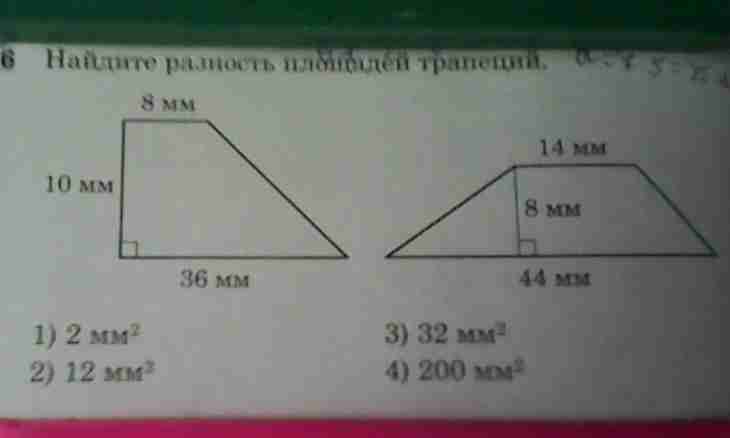Trapeze is called the quadrangle which two parties are each other parallel. A basic formula of the area of a trapeze - the work of the half-sum of the basis on height. In some geometrical tasks on finding of the area of a trapeze it is impossible to use a basic formula, but lengths of diagonals are given. What should I do?
Instruction
1. The general to a formulaispolzuyta the general formula of the area for any quadrangle: S=1/2·AC. BD • sinφ where AC and BD are lengths of diagonals, φ - a corner between diagonals.
2. If it is required to prove or remove this formula, break a trapeze into 4 triangles. Write down a formula of the area of each of triangles (1/2 works of the parties on a sine of the angle between them). Take that corner which is formed by crossing of diagonals. Further use property of additivity of the area: write down the area of a trapeze as the sum of the areas of the triangles forming it. Group composed, having put a multiplier 1/2 and a sine outside brackets (considering that sin (180 °-φ) =sinφ). Receive an initial formula of the area of a quadrangle. In general, it is useful to consider the area of a trapeze as the sum of the areas of the triangles making it. Often it is a key to the solution of a task.
3. Important teoremyteorema which can be necessary if the numerical value of a corner between diagonals is not set in an explicit form: 1) The sum of all corners of a triangle is equal 180 °. Generally, the sum of all corners of a convex polygon is equal 180 ° • (n-2) where n is number of the parties of a polygon (equal to number of its corners).2) the Theorem of sine for a triangle with the parties of a, b and c: a/sinA=b/sinB=c/sinC where A, B, C are the corners lying opposite to the parties of a, b, c respectively. 3) Theorem of cosines for a triangle with the parties of a, b and c: with²=a²+b²-2·a· b·cosα, where α - the triangle corner formed by the parties of an and b. The theorem of cosines has the special case the well-known Pythagorean theorem since cos90 °=0.
4. Special characteristics of a trapeze - you ravnobokostyobratit attention to the properties of a trapeze specified in a statement of the problem. If the isosceles trapeze (sides are equal) is given, use that its property that diagonals are equal in it.
5. Special characteristics of a trapeze - existence direct uglayesl the rectangular trapeze (one of straight line trapeze corners) is given, consider the rectangular triangles which are in a trapeze. Remember that the area of a rectangular triangle is equal to a half of the work of its parties forming a right angle since sin90 °=1.
